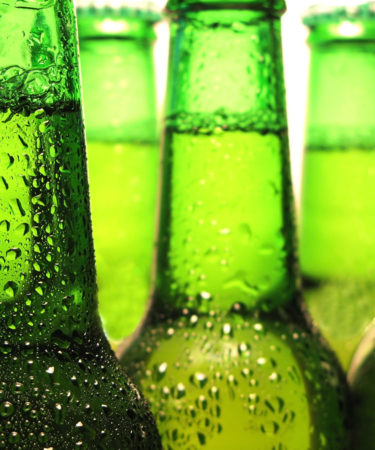Have you ever been driving and thought you passed a skunk, only to realize that smell was actually coming from the 6-pack of Corona in your backseat? We’re exaggerating, but Corona and other beers bottled in clear or green glass have developed a reputation as smelling “skunky” or spoiled. That’s because they are.
Most beers have hops, which often shape the beer’s taste. When hops are boiled with wort, they give off iso-alpha acids (also known as isohumulones), which are responsible for that bitter flavor IPA lovers crave. However, when a beer is exposed to UV light (say, the kind found in the sun), the light destroys the iso-alpha acids. The leftover chemicals hook up with sulfur-packed proteins, and produce a chemical compound that’s structurally (and smellably) similar to a skunk’s defense spray. In other words: without protection, UV-exposed beer smells. This is called the “light-struck” effect.
So just how does a brewery protect its beer from the harmful UV rays? After all, the beer will inevitably be exposed to sunlight before it ends up on the shelf, and more importantly, in your glass. The answer is that while you can’t sunscreen a brew, you can protect it with amber, or brown glass. It’s been established that brown glass protects a beer from skunkification, while green and clear glass doesn’t. While there is science to back this up, it’s also easy to find out for yourself. Buy a bottle of Stella Artois and a bottle of Sam Adam’s lager or another brown-bottled beer and smell the difference.
The question then remains, why would any brewery continue to bottle their beer in green or clear bottles, knowing full well that what awaits the consumer is spoiled beer? The answer is complicated. On one hand, some of it may have to do with nostalgia, as odd as that sounds. People know Corona as a skunked beer, so those loyal to the brand might not want a change in taste. However, there may be another explanation for why beer companies – specifically European beer companies – sell their products in green bottles.
According to some sources, during World War II, there was a brown glass shortage, which forced European brewers to bottle their beer in green or clear glass. The green glass bottles came to be associated with more expensive or higher quality beer. It makes sense, when you think about it: which looks more luxe, Heineken or Corona? The tradition stuck around, and now green bottles exist simply for aesthetic and marketing purposes. We’ve seen similar marketing ploys in wine when it comes to why bottles have punts.
In any event, if you like “skunked” beer (some of us do), there’s no shame. The taste has been around since we were born, and many of us know it as a mainstream beer flavor. Plus, we know that when it comes to alcohol, apparent faults – like, say, mold – aren’t always a bad thing.
